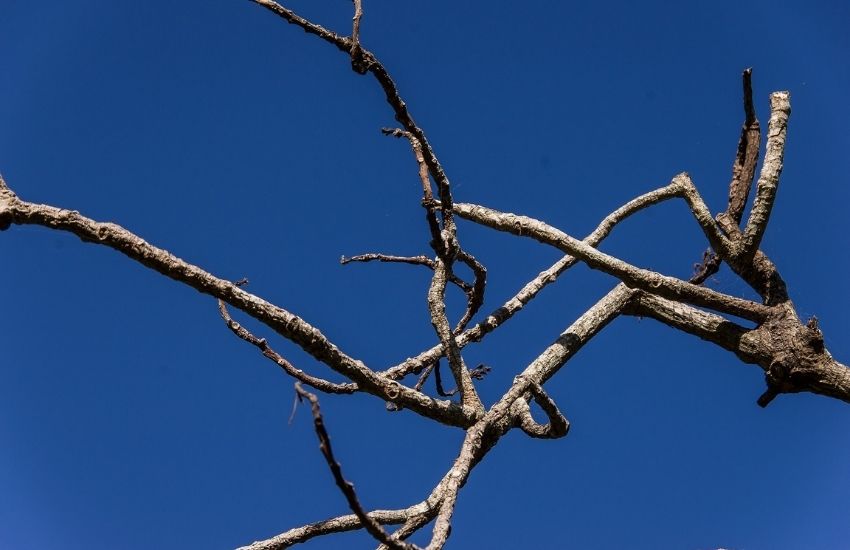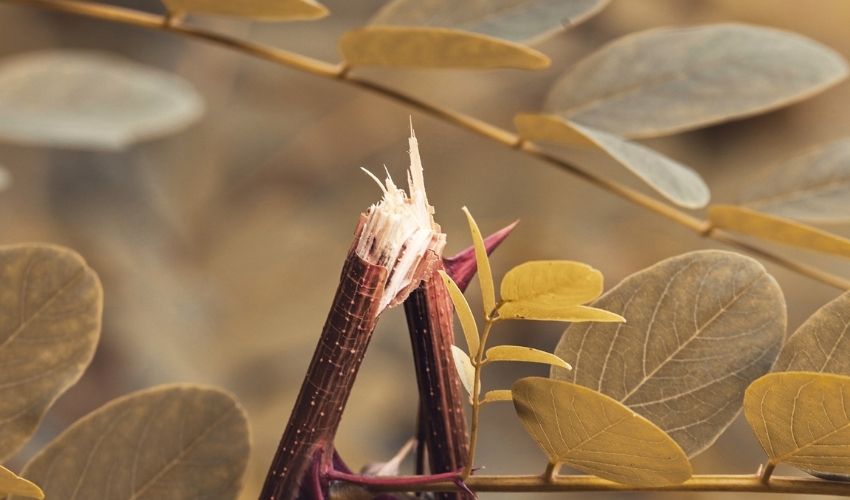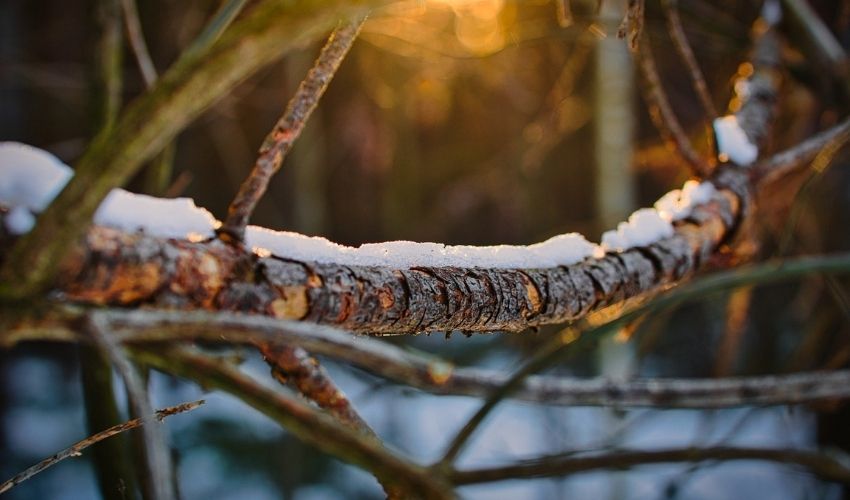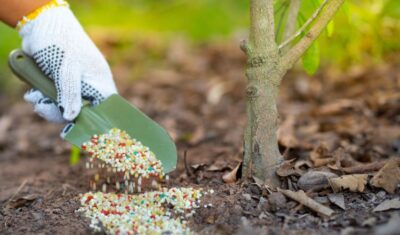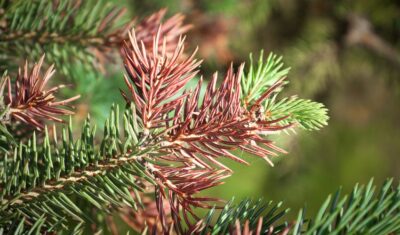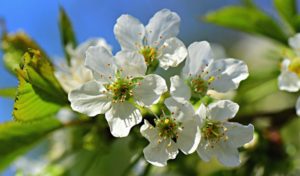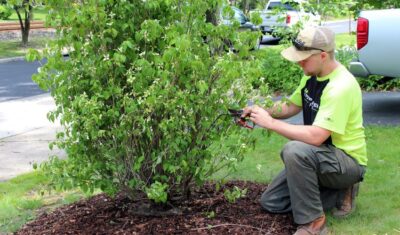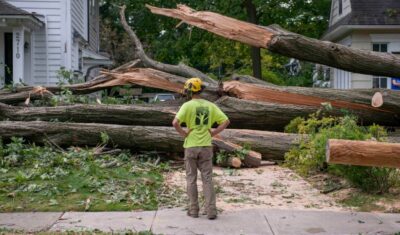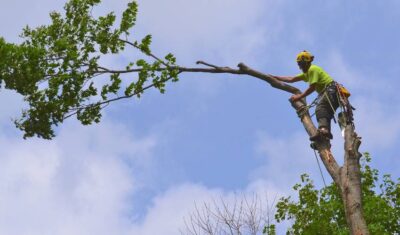It’s not always easy to tell whether a branch or twig is dead or just dormant, especially in winter or early spring before leaves emerge. Even during the growing season, a branch can appear to be dead but is actually still living. But there are some “signs of life” you can look for to see if a branch is dead or alive. It requires some sleuthing, some experience, and the tips below.
Why It’s Important to Know if a Branch is Dead or Alive
Certain types of tree work, such as pruning, rely on clearly identifying which branches are dead. Aside from the unattractive look of dead branches in a tree, they’re also hazardous to those below and should always be removed. Because dead branches are brittle and prone to breakage, arborists working in the tree canopy must also avoid using them as support.
Live branches may be pruned differently than dead ones. For example, live branches may be cut back to a lateral rather than cutting off the entire branch, or they may be pruned at different times (e.g., living branches on oak trees are pruned in October through early April to avoid spreading oak wilt).
Winter is an excellent time to prune trees. Even without any leaves on the branches, skilled arborists are able to distinguish deadwood from dormant branches.
For example, a heat-stressed tree may drop its leaves out of season, but its bare branches don’t mean that it’s dead. A spruce tree may have plenty of needles on its branches, but that doesn’t guarantee it’s alive.
So how do you tell if a branch or tree is dead or alive?
Signs That a Tree or Branch is Alive
It’s usually easier to know if a tree (or shrub) is alive – just look for these signs of a healthy tree:
- Intact outer bark that’s firmly attached, with no cracks or splits
- Flexible branches and twigs that don’t snap when gently bent
- No frass, sawdust, or decayed material on or beneath the tree
- Foliage on all branches during the growing season or no persistent dead leaves during dormancy (unless they’re characteristic of the species)
While these things don’t guarantee that your tree is in robust health, they’re good indicators that it’s alive. Arborists and tree care professionals use these signs as part of their initial evaluation of any tree.
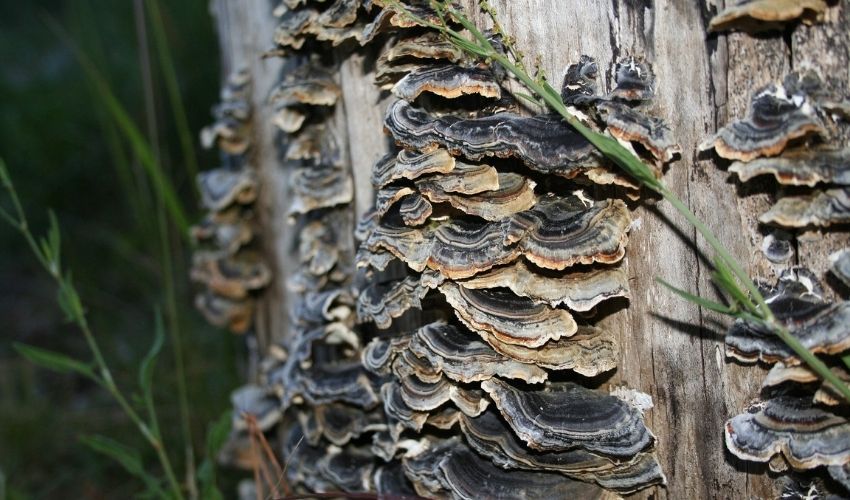
Turkey tail fungus is usually a clear indicator that the tree is dead.
Signs That a Tree or Branch is Dead or Dying
Below are specific things to look for to help determine if a branch (or an entire) tree is dead or alive.
Fungal Growth or Decay on a Tree’s Trunk or Branches
When a tree is no longer generating new growth, its external bark is no longer replenished by outward growing cell layers (tree rings) and loses its thickness and flexibility. The once impervious bark layer can become dry and porous and allow fungus to anchor itself and grow.
- If you see certain types of fungal growth, such as the turkey tail fungus (Trametes versicolor) which grows on dead trees and stumps, you’ll know your tree is dead.
- Fungal growths such as mushrooms or strands take time to develop and often appear well after an infection has weakened or killed the host tree.
- A more extensive examination involves pruning off a branch and cutting it crosswise to expose its interior bark and growth rings, which will show areas of internal decay.
NOTE: Lichen, which is a fungus and algae hybrid, does not damage trees or cause their death. Learn more about lichen >>
Insect Damage
- Frass, or insect poop, will appear where insects have established themselves under tree bark or within a tree branch or trunk wood.
- Along with other symptoms, frass is an indicator that a tree was unable to fend off insect attacks.
- Emerald ash borer, which kills ash trees, is a common culprit here in Northeast Ohio
Falling Leaves and Twigs
When a tree drops twigs and leaves during the growing season, it can indicate that the tree is:
- in decline and no longer supporting active growth,
- in poor health and unable to defend itself against damage from disease and insect damage, or
- that disease has already killed its internal vascular system (this is what distributes water and nutrients to all parts of the tree).
Falling leaves in summer can also be a sign of heat stress, which doesn’t necessarily mean the tree is dying. With proper care, a heat-stressed tree can recover.
Likewise, leaves that hang on instead of dropping in the fall can mean that the tree is no longer vigorous and sending out the chemical signals that control its growth. Be careful though – some trees, such as oaks, tend to hang onto their dead leaves well into winter.
Buds on Twigs
Trees are masters of resource management; many will develop leaf and flower buds months before they’re scheduled to open. Developed buds often wait through winter before opening in spring. The condition of those buds gives you a good indication of whether the branch is dead or simply dormant.
- A living, healthy tree will have smooth, shiny, and well-formed buds. Each bud is protected from winter weather by an intact outer covering.
- Dry, shriveled buds are a sign that the tree’s twig or branch is no longer receiving water and nutrients. In this case, it may already be dead.
Branch Flexibility
Healthy, living branches (and trunks) are flexible by design. Flexibility allows a tree to withstand winter storms and high winds by moving with the forces of weather instead of fighting against them.
When a tree is dead or dying, its branches become rigid and dry. To see how brittle branches are, try the “snap test.”
- Hold a small branch or twig in both hands, with your hands about 6 inches apart.
- Gently bend the branch or twig a little (you’re not trying to bend it in half!).
- If it bends, it’s most likely alive. If it snaps, it’s probably dead.
Bark Condition
Trees are complex and so is their bark. The outer bark is what we see when we look at a tree. But the hidden, inner bark layers are just as important.
The inner bark layers called the cambium and the phloem, are the vital peripheral growth rings of a tree. This is where new wood layers are created and nutrients are distributed to all parts of the tree.
To see whether a branch is dead or alive, try the “scratch test.”
- Gently scratch off the outer bark on a twig or branch to expose the inner bark.
- If the inner bark is moist, flexible, green, and looks fresh, the branch is probably alive. If it’s dry and brittle, the twig or branch is not living.
PRO TIP: Don’t scratch the bark out of curiosity on a living branch that’s attached to a tree. You’ll create an opening for disease or pests to get into your tree’s system.
If Your Tree is Dead or Dying
As soon as you notice changes to your tree that don’t look good, call an arborist.
- Dead branches won’t come back to life, and are dangerous! Don’t climb up to take a closer look.
- Dead branches can drop at any time and are considered hazards. There’s a reason why dead, hanging branches are often referred to as “widow makers.”
- If it’s your tree, you’re responsible for preventing damage to people and property from a failing tree.
- In addition to damaging property, falling branches can take out other branches on their way down, creating more tree damage that you’ll need to repair.
(And yes, in a forest or in your garden, it makes a sound).
Need a Hand?
Winter is the ideal time to prune trees and to evaluate tree health. Our crews work through the winter (except when the weather is dangerous) and are experienced in evaluating trees and tree health (yes, we can tell if a branch is dead or alive – even in winter). If you’re concerned about any of your trees, give us a call. We’ll evaluate your trees and give you realistic advice and information about the health of your trees.
Dead or Dormant?
If a branch or section of a tree is too high to reach or you are worried that a tree may be dead rather than dormant, contact Independent Tree. We can assess your trees and remove any dangerous trees or dead branches before they become a safety hazard.Recent Articles
Topics
About The Author

STAY IN THE LOOP
WITH OUR
LATEST UPDATES
"*" indicates required fields

